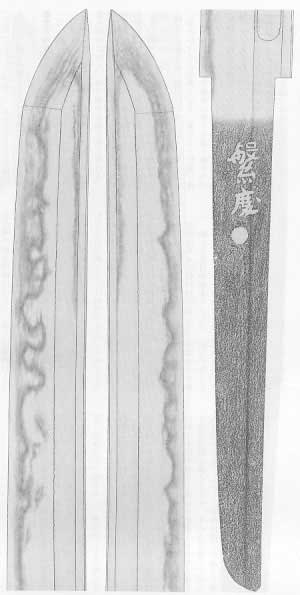NYUSATSU-KANTEI-TO OF THE 41ST ANNUAL CONVENTION
No.4 Katana
| Mei: | “HANKEI” |
| Ha-watari: | 69.2 cm |
| Sori: | 1.83 cm |
| Shinogi-zukuri | |
| Mitsu-mune | |
| Jihada: |
Itame-hada combined with mokume and some open hada in company with
thick ji-nie and a lot of thick chikei.
|
|
| Hamon: |
Gentle notare
mixed with ko-notare and choji in thick nie-deki then gunome-ashi,
kinsuji, sunagashi and tobi-yaki that look like yubashiri.
|
|
| Boshi: |
Wide sugu then
turns back in ko-maru with many hakikake and long kaeri. It looks
like kaen-boshi.
|
|
| Horimono: | Bo-hi with round end is carved on the lower half shinogi-ji of the omote and futa-suji-bi with round end on the ura. |
This is a work of Soshu-den smith so that the jihada is covered with thick ji-nie and the hamon consists of thick nie then many kinsuji and chikei are seen inside the hamon.
At a glance, the blade looks like a work of old Soshu-den smith since conspicuous itame-hada stands out in the shinogi-ji too and the hamon consists of high quality nie. Votes concentrated on Keicho-shinto since the blade has a stout sugata with thick kasane.
This is a work of Keicho-shinto by Hankei. Soshu-den was very popular across the country in the Keicho Era and many swordsmiths challenged old master smiths of Soshu-den. Hankei is one of the most distinguished smiths among them.
This blade unusually shows a gentle workmanship with narrower hamon and relatively dense itame-hada. Though the jihada combines o-itame-hada and thick chikei called ‘hijiki-hada’ are sporadically seen in it. Then the nioi-guchi is subdued and the border between the hamon and the jihada is not clear as a result that thick nie smoke up toward the jihada.
Open hada (not tightly welded part) is often seen in the jihada of Hankei and becomes the state of kizu or ji-ware. Several open hada are seen in the jihada of this blade as usual. High mitsu-mune at sharp angle is another feature of Hankei.
There were many votes for Keicho-shinto, particularly Nanki Shigekuni. Shigekuni is certainly good at Soshu-den as well as Yamato-den that is his family tradition. The manner of the boshi (kaen and many hakikake) might lead people to vote for him. Though this boshi has very long kaeri and Shigekuni never tempers boshi with such long kaeri and Shigekuni does not make high and sharp-angled mitsu-mune.
